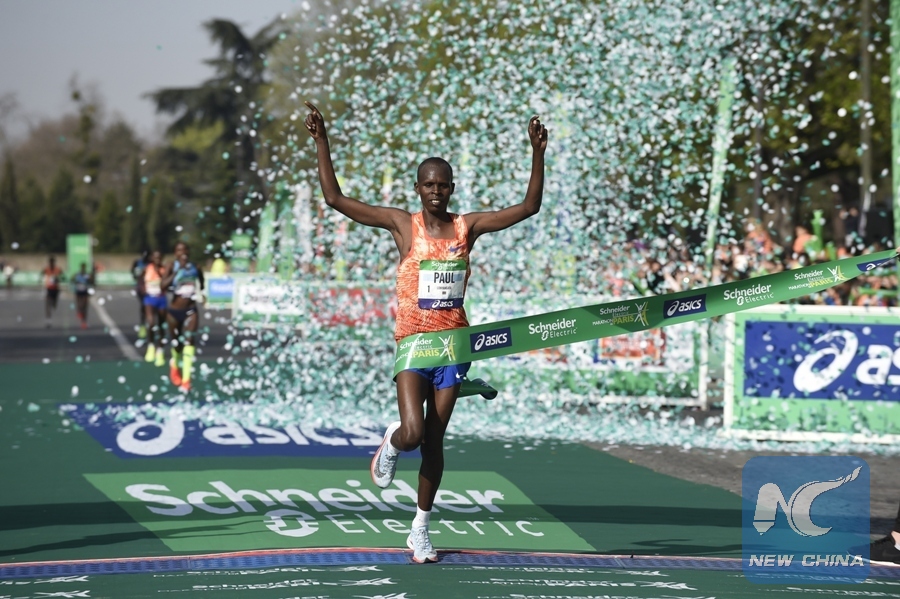
File Photo: Kenyan athlete Paul Lonyangata passes the finishing line and wins the men's champion with 2 hours 6 minutes and 25 seconds in Paris, France on April 8, 2018. (Xinhua/Jean-Marie Hervio)
WASHINGTON, Sept. 12 (Xinhua) -- American researchers found that two to three million years ago, the functional loss of a single gene made humanity into best long-distance runners in the animal kingdom.
In a paper to be published on Wednesday in the Proceedings of the Royal Society B, researchers at University of California (UC) San Diego School of Medicine reported on studies of mice engineered to lack the same gene, called CMAH, and this lost gene triggered a series of significant changes in what would eventually become the modern human species.
At roughly the same time as the CMAH mutation took hold, human ancestors were transitioning from forest dwellers to life primarily upon the arid savannahs of Africa, according to the study.
While they were already walking upright, the bodies and abilities of these early hominids were evolving dramatically, in particular major changes in skeletal biomechanics and physiology that resulted in long, springy legs, big feet, powerful gluteal muscles and an expansive system of sweat glands that were able to dissipate heat much more effectively than other larger mammals.
Such changes helped fuel the emergence of the human ability to run long distances relatively tirelessly, allowing ancestors to hunt in the heat of the day when other carnivores were resting and to pursue prey to their point of exhaustion, a technique called persistence hunting.
"We discovered this first clear genetic difference between humans and our closest living evolutionary relatives, the chimpanzees, more than 20 years ago," said the paper's senior author Ajit Varki, Distinguished Professor of Medicine and Cellular and Molecular Medicine at UC San Diego School of Medicine.
Given the approximate timing of the mutation and its documented impact on fertility in a mouse model with the same mutation, Varki's team began investigating how the genetic difference might have contributed to the origin of Homo, the genus that includes modern Homo sapiens and extinct species like Homo habilis and Homo erectus.
"We evaluated the exercise capacity (of mice lacking the CMAH gene), and noted an increased performance during treadmill testing and after 15 days of voluntary wheel running," said Jon Okerblom, the study's first author.
They also found that the mice displayed greater resistance to fatigue, increased mitochondrial respiration and hind-limb muscle, with more capillaries to increase blood and oxygen supply.
Those observations suggested that CMAH loss contributed to improved skeletal muscle capacity for oxygen utilization.
"If the findings translate to humans, they may have provided early hominids with a selective advantage in their move from trees to becoming permanent hunter-gatherers on the open range," Varki said.
When the CMAH gene mutated in the genus Homo two to three million years ago, perhaps in response to evolutionary pressures caused by an ancient pathogen, it altered how subsequent hominids and modern humans used sialic acids, a family of sugar molecules that coat the surfaces of all animal cells, where they serve as vital contact points for interaction with other cells and with the surrounding environment.
The human mutation caused loss of a sialic acid called Neu5Gc and accumulation of its precursor called Neu5Ac, which differs by only a single oxygen atom. This seemingly minor difference affects almost every cell type in the human body.
The researchers have linked the loss of the CMAH gene and sialic acids to not just improved long-distance running ability, but also enhanced innate immunity in early hominids.
However, they have also reported that certain sialic acids were associated with increased risk of type 2 diabetes and they might contribute to elevated cancer risk associated with red meat consumption.
"They are a double-edged sword," said Varki. "The consequence of a single lost gene and a small molecular change that appears to have profoundly altered human biology and abilities going back to our origins."

